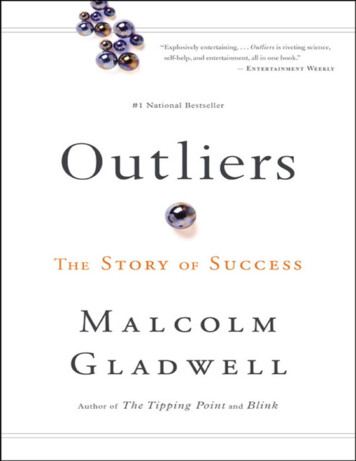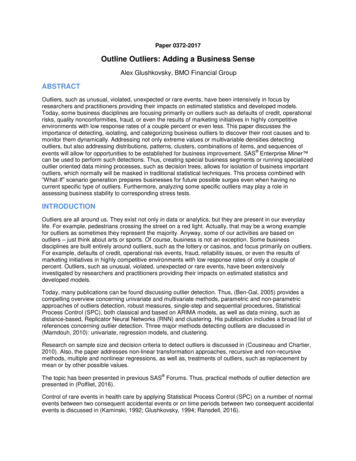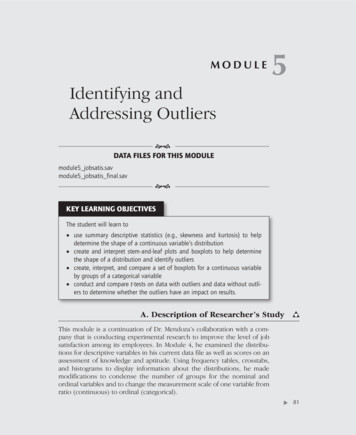
Transcription
OUTLIERSThe Story of SuccessMALCOLM GLADWELLBACK BAY BOOKSLITTLE, BROWN AND COMPANYNEW YORK BOSTON LONDON
Begin ReadingTable of ContentsReading Group GuideCopyright Page
For Daisy
INTRODUCTIONThe Roseto Mystery“THESE PEOPLE WERE DYING OF OLD AGE. THAT’S IT.”out·li·er \-,l ( )r\ noun1: something that is situated away from or classed differently from a main orrelated body2: a statistical observation that is markedly different in value from the othersof the sample1.Roseto Valfortore lies one hundred miles southeast of Rome in the Apenninefoothills of the Italian province of Foggia. In the style of medieval villages,the town is organized around a large central square. Facing the square is thePalazzo Marchesale, the palace of the Saggese family, once the greatlandowner of those parts. An archway to one side leads to a church, theMadonna del Carmine—Our Lady of Mount Carmine. Narrow stone stepsrun up the hillside, flanked by closely clustered two-story stone houses withred-tile roofs.For centuries, the paesani of Roseto worked in the marble quarries in thesurrounding hills, or cultivated the fields in the terraced valley below,walking four and five miles down the mountain in the morning and thenmaking the long journey back up the hill at night. Life was hard. Thetownsfolk were barely literate and desperately poor and without much hopefor economic betterment until word reached Roseto at the end of thenineteenth century of the land of opportunity across the ocean.In January of 1882, a group of eleven Rosetans—ten men and one boy—
set sail for New York. They spent their first night in America sleeping on thefloor of a tavern on Mulberry Street, in Manhattan’s Little Italy. Then theyventured west, eventually finding jobs in a slate quarry ninety miles west ofthe city near the town of Bangor, Pennsylvania. The following year, fifteenRosetans left Italy for America, and several members of that group ended upin Bangor as well, joining their compatriots in the slate quarry. Thoseimmigrants, in turn, sent word back to Roseto about the promise of the NewWorld, and soon one group of Rosetans after another packed their bags andheaded for Pennsylvania, until the initial stream of immigrants became aflood. In 1894 alone, some twelve hundred Rosetans applied for passports toAmerica, leaving entire streets of their old village abandoned.The Rosetans began buying land on a rocky hillside connected to Bangorby a steep, rutted wagon path. They built closely clustered two-story stonehouses with slate roofs on narrow streets running up and down the hillside.They built a church and called it Our Lady of Mount Carmel and named themain street, on which it stood, Garibaldi Avenue, after the great hero ofItalian unification. In the beginning, they called their town New Italy. Butthey soon changed it to Roseto, which seemed only appropriate given thatalmost all of them had come from the same village in Italy.In 1896, a dynamic young priest by the name of Father Pasquale de Niscotook over at Our Lady of Mount Carmel. De Nisco set up spiritual societiesand organized festivals. He encouraged the townsfolk to clear the land andplant onions, beans, potatoes, melons, and fruit trees in the long backyardsbehind their houses. He gave out seeds and bulbs. The town came to life. TheRosetans began raising pigs in their backyards and growing grapes forhomemade wine. Schools, a park, a convent, and a cemetery were built.Small shops and bakeries and restaurants and bars opened along GaribaldiAvenue. More than a dozen factories sprang up making blouses for thegarment trade. Neighboring Bangor was largely Welsh and English, and thenext town over was overwhelmingly German, which meant—given thefractious relationships between the English and Germans and Italians in thoseyears—that Roseto stayed strictly for Rosetans. If you had wandered up anddown the streets of Roseto in Pennsylvania in the first few decades after1900, you would have heard only Italian, and not just any Italian but theprecise southern Foggian dialect spoken back in the Italian Roseto. Roseto,Pennsylvania, was its own tiny, self-sufficient world—all but unknown by
the society around it—and it might well have remained so but for a mannamed Stewart Wolf.Wolf was a physician. He studied digestion and the stomach and taught inthe medical school at the University of Oklahoma. He spent his summers on afarm in Pennsylvania, not far from Roseto—although that, of course, didn’tmean much, since Roseto was so much in its own world that it was possibleto live in the next town and never know much about it. “One of the timeswhen we were up there for the summer—this would have been in the latenineteen fifties—I was invited to give a talk at the local medical society,”Wolf said years later in an interview. “After the talk was over, one of thelocal doctors invited me to have a beer. And while we were having a drink,he said, ‘You know, I’ve been practicing for seventeen years. I get patientsfrom all over, and I rarely find anyone from Roseto under the age of sixtyfive with heart disease.’ ”Wolf was taken aback. This was the 1950s, years before the advent ofcholesterol-lowering drugs and aggressive measures to prevent heart disease.Heart attacks were an epidemic in the United States. They were the leadingcause of death in men under the age of sixty-five. It was impossible to be adoctor, common sense said, and not see heart disease.Wolf decided to investigate. He enlisted the support of some of hisstudents and colleagues from Oklahoma. They gathered together the deathcertificates from residents of the town, going back as many years as theycould. They analyzed physicians’ records. They took medical histories andconstructed family genealogies. “We got busy,” Wolf said. “We decided todo a preliminary study. We started in nineteen sixty-one. The mayor said,‘All my sisters are going to help you.’ He had four sisters. He said, ‘You canhave the town council room.’ I said, ‘Where are you going to have councilmeetings?’ He said, ‘Well, we’ll postpone them for a while.’ The ladieswould bring us lunch. We had little booths where we could take blood, doEKGs. We were there for four weeks. Then I talked with the authorities. Theygave us the school for the summer. We invited the entire population ofRoseto to be tested.”The results were astonishing. In Roseto, virtually no one under fifty-fivehad died of a heart attack or showed any signs of heart disease. For men oversixty-five, the death rate from heart disease in Roseto was roughly half that ofthe United States as a whole. The death rate from all causes in Roseto, in fact,
was 30 to 35 percent lower than expected.Wolf brought in a friend of his, a sociologist from Oklahoma named JohnBruhn, to help him. “I hired medical students and sociology grad students asinterviewers, and in Roseto we went house to house and talked to everyperson aged twenty-one and over,” Bruhn remembers. This happened morethan fifty years ago, but Bruhn still had a sense of amazement in his voice ashe described what they found. “There was no suicide, no alcoholism, no drugaddiction, and very little crime. They didn’t have anyone on welfare. Thenwe looked at peptic ulcers. They didn’t have any of those either. Thesepeople were dying of old age. That’s it.”Wolf’s profession had a name for a place like Roseto—a place that layoutside everyday experience, where the normal rules did not apply. Rosetowas an outlier.2.Wolf’s first thought was that the Rosetans must have held on to some dietarypractices from the Old World that left them healthier than other Americans.But he quickly realized that wasn’t true. The Rosetans were cooking with lardinstead of with the much healthier olive oil they had used back in Italy. Pizzain Italy was a thin crust with salt, oil, and perhaps some tomatoes, anchovies,or onions. Pizza in Pennsylvania was bread dough plus sausage, pepperoni,salami, ham, and sometimes eggs. Sweets such as biscotti and taralli used tobe reserved for Christmas and Easter; in Roseto they were eaten year-round.When Wolf had dieticians analyze the typical Rosetan’s eating habits, theyfound that a whopping 41 percent of their calories came from fat. Nor wasthis a town where people got up at dawn to do yoga and run a brisk six miles.The Pennsylvanian Rosetans smoked heavily and many were struggling withobesity.If diet and exercise didn’t explain the findings, then what about genetics?The Rosetans were a close-knit group from the same region of Italy, andWolf’s next thought was to wonder whether they were of a particularly hardystock that protected them from disease. So he tracked down relatives of theRosetans who were living in other parts of the United States to see if theyshared the same remarkable good health as their cousins in Pennsylvania.
They didn’t.He then looked at the region where the Rosetans lived. Was it possiblethat there was something about living in the foothills of eastern Pennsylvaniathat was good for their health? The two closest towns to Roseto were Bangor,which was just down the hill, and Nazareth, a few miles away. These wereboth about the same size as Roseto, and both were populated with the samekind of hardworking European immigrants. Wolf combed through bothtowns’ medical records. For men over sixty-five, the death rates from heartdisease in Nazareth and Bangor were three times that of Roseto. Anotherdead end.What Wolf began to realize was that the secret of Roseto wasn’t diet orexercise or genes or location. It had to be Roseto itself. As Bruhn and Wolfwalked around the town, they figured out why. They looked at how theRosetans visited one another, stopping to chat in Italian on the street, say, orcooking for one another in their backyards. They learned about the extendedfamily clans that underlay the town’s social structure. They saw how manyhomes had three generations living under one roof, and how much respectgrandparents commanded. They went to mass at Our Lady of Mount Carmeland saw the unifying and calming effect of the church. They counted twentytwo separate civic organizations in a town of just under two thousand people.They picked up on the particular egalitarian ethos of the community, whichdiscouraged the wealthy from flaunting their success and helped theunsuccessful obscure their failures.In transplanting the paesani culture of southern Italy to the hills of easternPennsylvania, the Rosetans had created a powerful, protective social structurecapable of insulating them from the pressures of the modern world. TheRosetans were healthy because of where they were from, because of theworld they had created for themselves in their tiny little town in the hills.“I remember going to Roseto for the first time, and you’d see threegenerational family meals, all the bakeries, the people walking up and downthe street, sitting on their porches talking to each other, the blouse millswhere the women worked during the day, while the men worked in the slatequarries,” Bruhn said. “It was magical.”When Bruhn and Wolf first presented their findings to the medicalcommunity, you can imagine the kind of skepticism they faced. They went toconferences where their peers were presenting long rows of data arrayed in
complex charts and referring to this kind of gene or that kind of physiologicalprocess, and they themselves were talking instead about the mysterious andmagical benefits of people stopping to talk to one another on the street and ofhaving three generations under one roof. Living a long life, the conventionalwisdom at the time said, depended to a great extent on who we were—that is,our genes. It depended on the decisions we made—on what we chose to eat,and how much we chose to exercise, and how effectively we were treated bythe medical system. No one was used to thinking about health in terms ofcommunity.Wolf and Bruhn had to convince the medical establishment to think abouthealth and heart attacks in an entirely new way: they had to get them torealize that they wouldn’t be able to understand why someone was healthy ifall they did was think about an individual’s personal choices or actions inisolation. They had to look beyond the individual. They had to understand theculture he or she was a part of, and who their friends and families were, andwhat town their families came from. They had to appreciate the idea that thevalues of the world we inhabit and the people we surround ourselves withhave a profound effect on who we are.In Outliers, I want to do for our understanding of success what StewartWolf did for our understanding of health.
PART ONEOPPORTUNITY
CHAPTER ONEThe Matthew Effect“FOR UNTO EVERYONE THAT HATH SHALL BE GIVEN, AND HE SHALL HAVEABUNDANCE. BUT FROM HIM THAT HATH NOT SHALL BE TAKEN AWAY EVENTHAT WHICH HE HATH.”—MATTHEW25:291.One warm, spring day in May of 2007, the Medicine Hat Tigers and theVancouver Giants met for the Memorial Cup hockey championships inVancouver, British Columbia. The Tigers and the Giants were the two finestteams in the Canadian Hockey League, which in turn is the finest juniorhockey league in the world. These were the future stars of the sport—seventeen-, eighteen-, and nineteen-year-olds who had been skating andshooting pucks since they were barely more than toddlers.The game was broadcast on Canadian national television. Up and downthe streets of downtown Vancouver, Memorial Cup banners hung from thelampposts. The arena was packed. A long red carpet was rolled out on the ice,and the announcer introduced the game’s dignitaries. First came the premierof British Columbia, Gordon Campbell. Then, amid tumultuous applause, outwalked Gordie Howe, one of the legends of the game. “Ladies andgentlemen,” the announcer boomed. “Mr. Hockey!”For the next sixty minutes, the two teams played spirited, aggressivehockey. Vancouver scored first, early in the second period, on a rebound byMario Bliznak. Late in the second period, it
outliers the story of success malcolm gladwell back bay books little, brown and company new york boston london











